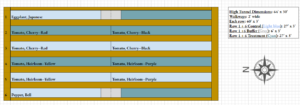Project Overview
Information Products
Commodities
- Vegetables: eggplant, peppers, tomatoes
Practices
- Crop Production: fertilizers, high tunnels or hoop houses, season extension
- Education and Training: demonstration, farmer to farmer, on-farm/ranch research
- Natural Resources/Environment: carbon sequestration
- Soil Management: organic matter, soil analysis, soil chemistry, soil quality/health
- Sustainable Communities: local and regional food systems, sustainability measures, values-based supply chains
Proposal summary:
U.S. agriculture contributes
significantly to the country’s greenhouse gas emissions, and
nowhere is that more relevant than Iroquois county—ZA’s location
and the 2nd highest corn producing county in the nation. For this
reason, a strategy of applying basalt rock to sequester carbon
and balance pH in agricultural soils, known as enhanced rock
weathering (ERW) is quickly gaining momentum among researchers
and investors. Most research and investments have been in
large-scale conventional commodity crop systems. Very little is
known about the effect of ERW in horticultural systems. ERW could
be a key component of the transition to a more sustainable and
abundant food system, but it must complement a shift towards more
diverse and nourishing agricultural practices, rather than
bolstering chemical-intensive monocropped systems.
Project objectives from proposal:
Tomatoes, peppers, and eggplants
will be grown in a 64’ x 30’ high tunnel oriented North-South,
researching the effect of basalt application on plant yield,
plant health, and soil quality. There are 6 in-ground rows
measuring 60’ x 3’. Rows 1 and 6 are divided up into 27’ lengths
each for the control and basalt treatment, with a 6’ buffer in
between. Rows 2 and 4 will receive basalt treatment and Rows 3
and 5 serve as controls (see attached planting layout). Treatment
plots will receive basalt rock fertilizer once in 2024, applied
and turned into the top 4-6” at Spring soil preparation prior to
planting; at a rate of 0.23 kg/sq ft, totaling 18.6 kg each for
Rows 1 and 6, and 82.8 kg each for Rows 2 and 4.
Crops by numbered Row are
outlined below:
- Japanese eggplant
- Cherry tomato–Red, Cherry
tomato–Black - Cherry tomato–Red, Cherry
tomato–Black - Heirloom tomato–Yellow,
Heirloom tomato–Purple - Heirloom tomato–Yellow,
Heirloom tomato–Purple - Bell pepper
Eggplants will be planted in 2
lines at 18” apart, totaling 80 plants; 36 plants as control, 8
plants as buffer, 36 plants receiving basalt treatment. Each row
of tomatoes will be planted at 18” apart, staggered down the
length of the row into 2 lines. For each of the 4 varieties of
tomato, 20 will be control and 20 will receive basalt treatment;
totaling 160 plants. Peppers will be planted in 2 lines at 12”
apart, totaling 120 plants; 54 plants as control, 12 plants as
buffer, 54 plants receiving basalt treatment. Crops will be
planted when soil temperature reaches 60 degrees Fahrenheit
overnight for a week.
Eggplants and peppers will be
supported using t-posts, stakes, and twine in a Florida weave
method. Tomato plants will be pruned 1-2 times weekly to 2
leaders strung up overhead using twine and clips, and height will
be maintained at 10’ for accessibility using the lower and lean
method. For optimal plant health, temperature will be monitored
with a greenhouse thermometer and maintained between 70 and 90
degrees F by opening and closing high tunnel vents and raising
and lowering the high tunnel sides. Plants will be fertilized at
recommended rates with Espoma Tomato-tone granular fertilizer
applied to all beds and turned into the top 4-6” at Spring soil
preparation before planting, and Neptune’s Harvest Hydrolyzed
Fish Fertilizer once monthly when plants begin to fruit. Straw
mulch will be laid down to reduce evaporation and weeds and keep
lower fruit from coming into contact with soil.
When plants begin to produce,
fruits will be harvested 2-3 times weekly, after reaching mature
fruit size and at least 50% ripeness. Yield will be weighed in
lbs individually by plot and analyzed using ANOVA. Plant health
in each plot will be assessed with biweekly visual observations
of plant vigor, monthly Brix test of foliage and fruit. Soil
quality in each plot will be assessed by sampling and analyzing
in a lab once in the Spring and Fall.
- Quantitatively evaluate the
effectiveness of applying basalt rock fertilizer on the yield
of eggplants, tomatoes, and peppers - Quantitatively and
qualitatively evaluate the effects plant health using Brix test
on fruit and foliage and regular observations - Quantitatively evaluate the
effects of basalt rock fertilizer on soil quality - Share research with community
members through field days, website and social media, and
discuss feasibility of basalt ERW in diversified horticultural
systems
